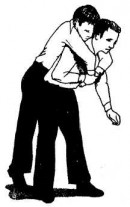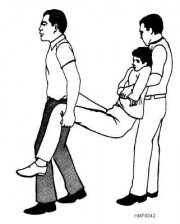Emergency Procedures
Please click here for a pdf of the emergency procedures handbook for the college.
Shelter in Place
During an evacuation, Emergency Team Leaders, Student Life staff, and other responsible persons should check all corridors and exit stairwells for any stranded person.
In the event that a person with disabilities is located who cannot reasonably leave the building with minimal assistance, and the emergency is not imminent, a responsible person should stay with the person with disabilities and “shelter in place”, either at the head of an interior, enclosed stairwell, or in a designated room, fitted with a sprinkler system, close by an open stairwell. Elevators may be used to evacuate persons with disabilities ONLY after emergency personnel have declared them safe to use. Call 911 and/or x7777 to alert emergency personnel about your circumstance.
In an imminent emergency, consideration should be given to immediate evacuation using lifts/carries described below.
Evacuating Blind or Low Vision Persons:
- Tell the person the nature of the emergency. Offer to guide him/her by offering your left/right elbow. Do not grab the person’s arm.
- Be sure the person brings with them all mobility aids such as white canes. The individual may have a guide dog that may be disoriented. Ask the advice of the person who is blind regarding your level of assistance.
- Give verbal directions to advise about the safest routes. Use compass directions, estimated distances and directional terms to orientate the person. As you walk, describe where you are and advise of any obstacles such as overhanging objects, curbs, etc.
- When you have reached a safe location, orient the person to where she/he is and ask if any further assistance is needed.
Evacuating Deaf or Hard of Hearing Persons:
- Write a note stating the emergency and the evacuation route (e.g., Fire: go out the rear door to the parking lot.).
- Turn the room lights on & off (if safe to do so) to gain attention. Indicate through hand gestures what is happening and what to do.
Evacuating Persons with Limited Mobility (e.g., using crutches, canes, or walkers):
For evacuation purposes, such persons should be treated as if they were injured. Carrying options include using a two-person lock arm position or having the person sit in a sturdy chair, preferably with arms.
Evacuating Persons Who Are Non-Ambulatory:
- When evacuating, always ask what method of assistance the person prefers.
- Not all persons can be removed from their wheelchairs and carried safely. The person may have a physical condition that contraindicates lifting, such as heart conditions or back problems or other severe physical complications.
- If transferring someone out of their wheelchair, note the location of the wheelchair and upon exiting the building immediately inform Campus Safety of the location of the wheelchair so they can retrieve it.
- Those with electric artificial respirators should be given priority assistance if there is smoke or fumes.
- Persons with chronic pain, catheter leg bags, fragility, or braces may not be able to extend or move extremities.
Transferring a Person:
- Check that the individual is not at risk when transferred or carried. The lifts/carries below can be employed.
- Pack-strap carry. Semi-ambulatory person may lean against the assistant’s back while the assistant holds both of the person’s arms over the assistant’s shoulders. The assistant leans forward slightly to take most of the person’s weight.
- Two-handed seat. Two assistants link arms to form a backrest and grip wrists to form a seat.
- Two-person carry. Two assistants carry a person by their extremities. One assistant stands behind and wraps arms around the person’s chest under their arms. Second assistant stands facing away from the person between their legs and lifts a person’s legs under knees with each arm or can cross the person’s legs over and carry them to one side, thus freeing one hand to open doors, etc.


Pack-strap carry Two-person carry
Moving a Person in a Wheelchair Down or Up a Flight of Stairs:
As in any situation involving the evacuation of a person with disabilities, if there is no imminent emergency, the person should be “sheltered in place”, as described earlier, until Portland Fire and Rescue, or other emergency personnel can assist. In an imminent emergency, consideration should be given to immediate evacuation. In that circumstance, it is recommended that the person be removed from the wheelchair and evacuated using the lifts/carries described earlier. However, if the decision is made to move the person in a wheelchair down or up a flight of stairs, follow these guidelines:
- If the person is to be moved in their wheelchair, it is desirable to have a minimum of two assisting persons, with four assisting persons preferred for adults with heavy wheelchairs.
- Secure the wheelchair seatbelt.
- The wheelchair battery should be removed if at all possible.
- Wheelchairs have many movable weak parts which were not constructed to withstand the stress of lifting (e.g., the seatbar footplates, wheels, movable armrests). The strongest person(s) should grip the chair handles at the back. Other assisting person(s) will grip the front seat frame or non-removable leg rests.
- Always keep the wheelchair facing away from the stairs.
- ROLL the wheelchair up or down the stairs. DO NOT carry as this may cause back trouble for the assistant. Let the wheelchair carry the weight.
- Keep the wheelchair slightly tilted back to keep the wheelchair user secure. However, do not tilt too far as this could cause the assistant to lose balance and pitch forward.
Student Accessibility is located in room 206 of Albany Quadrangle.
MSC: 112
email access@lclark.edu
voice 503-768-7192
fax 503-768-7197
Office Hours:
Monday through Friday
8:30 a.m. to 4:30 p.m.
CAS Exam Proctoring Hours:
Monday through Friday
8 a.m. to 4:30 p.m.
Student Accessibility
Lewis & Clark
615 S. Palatine Hill Road MSC 112
Portland OR 97219